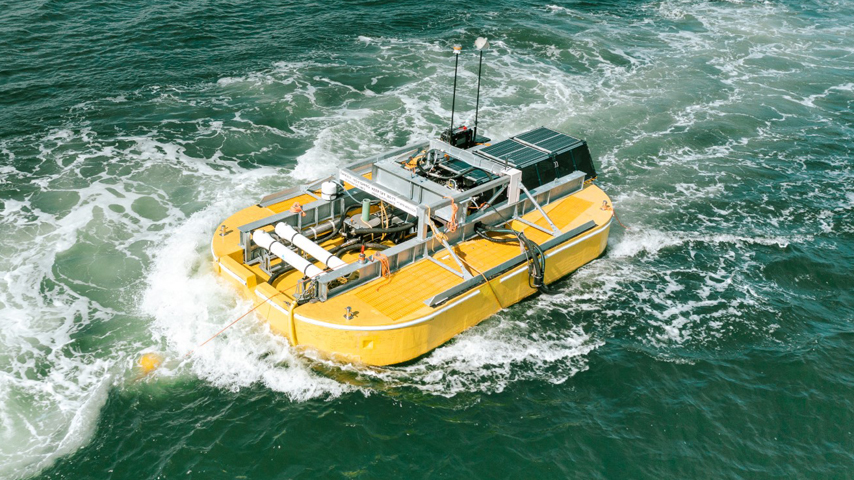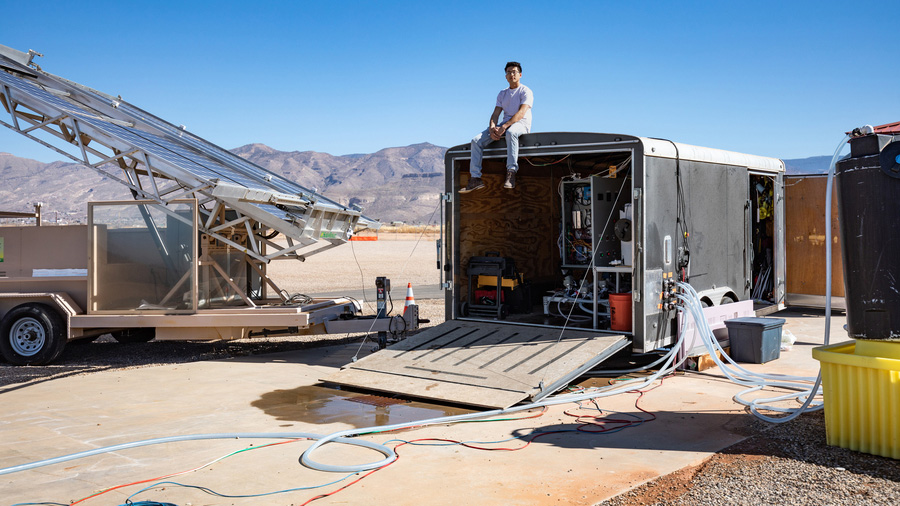Tapping the Ocean
Tapping the Ocean


Wave-powered desalination system produces drinking water without electricity.
Reliable sources of drinking water are shrinking globally as population increases and traditional sources become depleted or inadequate to meet growing needs. Coastal regions often turn to desalination plants to bolster drinking water supplies, but operating costs are high because of the energy load needed to operate them.
Bobbing in the background is a system that promises to reduce costs and meet climate goals by capturing wave energy to power an at-sea desalination system. The technology is in its infancy―the Department of Energy last year sponsored a competition to highlight wave-powered desalination systems―but Canadian firm Oneka, a finalist in the competition, now has two pilot plants operating that draw seawater and push it through a reverse-osmosis system using the power of waves.
“There’s been a lot of work done in this field,” said Shawn Meyer-Steele, Oneka’s chief commercial officer. “The real big difference is that most have a conversion step where they take the power that is generated by the waves…and they have a conversion where they convert it into electricity. Then they take the electricity and power desalination. We don’t have that energy step. We take the pressurized water and use that to push the water through membranes to create fresh water.”
Oneka’s system consists of a buoy anchored to the ocean floor on which R/O and other equipment are fitted. An intake is suspended from the bottom and includes a pipe that acts as piston to pump seawater onboard using ocean waves to pressurize the system. “About as much water goes through the reverse-osmosis membranes on the upward phase as it does in the downward phase,” Meyer-Steele said.
The system acts as a two-stage pumping system, he said. As the float rises water is pushed into the pressurization chamber, and about half of that volume into an energy recovery device. On the downward phase, brine is pushed into the chamber and discharged back into the ocean.
Become a Member: How to Join ASME
Brine is about 30 percent saltier than seaweater, according the to firm, a lower concentration compared to standard desalination plants. Dispersal into ocean currents does not harm sealife or affect overall ocean salinity, the company claims. Desalinated water is pumped through pipes to land for further treatment or distribution.
The company is building three sizes of systems, all of them modular so they can be easily expanded to meet needs. Pilot units can produce 2,600 gallons of water per day from a 17-foot x 8-foot buoy. That’s enough water for 20 to 300 people per day. So-called Icecube-class units are designed for emergency or disaster relief and produce 36 gallons of water per day.
One pilot unit has been operating off the coast of Fort Pierce, Fla., and a second in waters off of Chile. The company recently signed an agreement with Fort Bragg, Calif., for a third unit.
Meyer-Steele said Oneka now is working on a commercial-scale system that would provide 8,000 to 13,000 gallons of water per day. The Iceberg-class unit will sit on a 16-foot by 26-foot float.
Production will depend on wave height. The buoys will optimally operate at a minimum wave height of one meter, or three feet. They will be placed in water depths of 43 feet to 98 feet that are generally found about one-quarter to one-half mile offshore. Units would be placed at least 66 feet apart.
More for You: Fur-Lined Barrels Turn Ocean Swells to Electricity
Production costs for standard land-based thermal desalination plants generally range from $2 to $5 per 1,000 gallons. Meyer-Steele said Oneka’s system will be competitive and possibly less because it will not rely on electricity, which is a major cost component for energy-intensive desalination plants. After about eight years of development and testing, the buoys can withstand six-meter waves and can be disconnected and moved for more extreme weather.
Meyer-Steele said the biggest learning curve came in mastering the hydrodynamics of scaling up from the initial small units to larger ones. “It is also challenging from an engineering perspective in operating in a marine environment,” he said. “It’s different when you’re used to operating desalination and water treatment on land. Doing this in the open ocean is something else. "
In addition to water treatment and distribution skills, the firm also brought in engineering staff to handle marine and offshore engineering as well as hydrodynamics and oceanography. ”There’s different skill sets we’ve had to bring on,” said Meyer-Steele.
The company’s next step is scaling up to a size about ten times the size of the Iceberg unit, said Meyer-Steele. It would operate in the same one-meter wave height and is expected to be deployed either late this year or early 2024.
John Kosowatz in senior editor.
Bobbing in the background is a system that promises to reduce costs and meet climate goals by capturing wave energy to power an at-sea desalination system. The technology is in its infancy―the Department of Energy last year sponsored a competition to highlight wave-powered desalination systems―but Canadian firm Oneka, a finalist in the competition, now has two pilot plants operating that draw seawater and push it through a reverse-osmosis system using the power of waves.
“There’s been a lot of work done in this field,” said Shawn Meyer-Steele, Oneka’s chief commercial officer. “The real big difference is that most have a conversion step where they take the power that is generated by the waves…and they have a conversion where they convert it into electricity. Then they take the electricity and power desalination. We don’t have that energy step. We take the pressurized water and use that to push the water through membranes to create fresh water.”
Oneka’s system consists of a buoy anchored to the ocean floor on which R/O and other equipment are fitted. An intake is suspended from the bottom and includes a pipe that acts as piston to pump seawater onboard using ocean waves to pressurize the system. “About as much water goes through the reverse-osmosis membranes on the upward phase as it does in the downward phase,” Meyer-Steele said.
The system acts as a two-stage pumping system, he said. As the float rises water is pushed into the pressurization chamber, and about half of that volume into an energy recovery device. On the downward phase, brine is pushed into the chamber and discharged back into the ocean.
Become a Member: How to Join ASME
Brine is about 30 percent saltier than seaweater, according the to firm, a lower concentration compared to standard desalination plants. Dispersal into ocean currents does not harm sealife or affect overall ocean salinity, the company claims. Desalinated water is pumped through pipes to land for further treatment or distribution.
The company is building three sizes of systems, all of them modular so they can be easily expanded to meet needs. Pilot units can produce 2,600 gallons of water per day from a 17-foot x 8-foot buoy. That’s enough water for 20 to 300 people per day. So-called Icecube-class units are designed for emergency or disaster relief and produce 36 gallons of water per day.
One pilot unit has been operating off the coast of Fort Pierce, Fla., and a second in waters off of Chile. The company recently signed an agreement with Fort Bragg, Calif., for a third unit.
Meyer-Steele said Oneka now is working on a commercial-scale system that would provide 8,000 to 13,000 gallons of water per day. The Iceberg-class unit will sit on a 16-foot by 26-foot float.
Production will depend on wave height. The buoys will optimally operate at a minimum wave height of one meter, or three feet. They will be placed in water depths of 43 feet to 98 feet that are generally found about one-quarter to one-half mile offshore. Units would be placed at least 66 feet apart.
More for You: Fur-Lined Barrels Turn Ocean Swells to Electricity
Production costs for standard land-based thermal desalination plants generally range from $2 to $5 per 1,000 gallons. Meyer-Steele said Oneka’s system will be competitive and possibly less because it will not rely on electricity, which is a major cost component for energy-intensive desalination plants. After about eight years of development and testing, the buoys can withstand six-meter waves and can be disconnected and moved for more extreme weather.
Meyer-Steele said the biggest learning curve came in mastering the hydrodynamics of scaling up from the initial small units to larger ones. “It is also challenging from an engineering perspective in operating in a marine environment,” he said. “It’s different when you’re used to operating desalination and water treatment on land. Doing this in the open ocean is something else. "
In addition to water treatment and distribution skills, the firm also brought in engineering staff to handle marine and offshore engineering as well as hydrodynamics and oceanography. ”There’s different skill sets we’ve had to bring on,” said Meyer-Steele.
The company’s next step is scaling up to a size about ten times the size of the Iceberg unit, said Meyer-Steele. It would operate in the same one-meter wave height and is expected to be deployed either late this year or early 2024.
John Kosowatz in senior editor.






